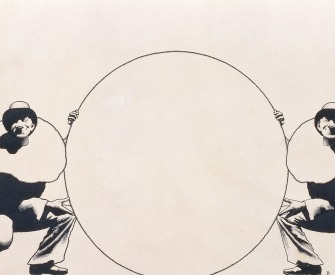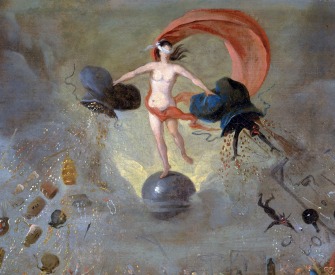The future comes like an unwelcome guest.
—Edmund Gosse, 1873Futures Market
The roots of Dutch tulip mania.
The tulip—so named, it is said, from a Turkish word, signifying a turban—was introduced into western Europe about the middle of the sixteenth century. Conrad Gesner, who claims the merit of having brought it into repute—little dreaming of the commotion it was shortly afterward to make in the world—says that he first saw it in the year 1559, in a garden at Augsburg, belonging to the learned Counselor Herwart, a man very famous in his day for his collection of rare exotics. The bulbs were sent to this gentleman by a friend at Constantinople, where the flower had long been a favorite. In the course of ten or eleven years after this period, tulips were much sought after by the wealthy, especially in Holland and Germany. Rich people at Amsterdam sent for the bulbs direct to Constantinople and paid the most extravagant prices for them. The first roots planted in England were brought from Vienna in 1600. Until the year 1634, the tulip annually increased in reputation, until it was deemed a proof of bad taste in any man of fortune to be without a collection of them. The rage for possessing them soon caught the middle classes of society, and merchants and shopkeepers, even of moderate means, began to vie with each other in the rarity of these flowers and the preposterous prices they paid for them. A trader at Haarlem was known to pay one-half of his fortune for a single root, not with the design of selling it again at a profit, but to keep in his own conservatory for the admiration of his acquaintances.
Many persons grow insensibly attached to that which gives them a great deal of trouble, as a mother often loves her sick and ever-ailing child better than her more healthy offspring. Upon the same principle we must account for the unmerited encomia lavished upon these fragile blossoms. In 1634, the rage among the Dutch to possess them was so great that the ordinary industry of the country was neglected, and the population, even to its lowest dregs, embarked in the tulip trade. As the mania increased, prices augmented until, in the year 1635, many persons were known to invest a fortune of 100,000 florins in the purchase of forty roots. It then became necessary to sell them by their weight in perits, a small weight less than a grain. A tulip of the species called Admiral Liefken, weighing 400 perits, was worth 4,400 florins; an Admiral Van der Eyck, weighing 446 perits, was worth 1,260 florins; a Childer of 106 perits was worth 1,615 florins; a Viceroy of 400 perits, 3,000 florins; and, most precious of all, a Semper Augustus, weighing 200 perits, was thought to be very cheap at 5,500 florins. The latter was much sought after, and even an inferior bulb might command a price of 2,000 florins. It is related that, at one time, early in 1636, there were only two roots of this description to be had in all Holland, and those not of the best. One was in the possession of a dealer in Amsterdam, and the other in Haarlem. So anxious were the speculators to obtain them that one person offered the fee-simple of twelve acres of building ground for the Haarlem tulip. That of Amsterdam was bought for 4,600 florins, a new carriage, two gray horses, and a complete set of harness.
The demand for tulips of a rare species increased so much in the year 1636 that regular marts for their sale were established on the stock exchange of Amsterdam, in Rotterdam, Haarlem, Leyden, Alkmar, Hoorn, and other towns. Symptoms of gambling now became, for the first time, apparent. The stock jobbers, ever on the alert for a new speculation, dealt largely in tulips, making use of all the means they so well knew how to employ to cause fluctuations in prices. At first, as in all these gambling manias, confidence was at its height, and everybody gained. The tulip jobbers speculated in the rise and fall of the tulip stocks, and made large profits by buying when prices fell, and selling out when they rose. Many individuals grew suddenly rich. A golden bait hung temptingly out before the people, and one after the other, they rushed to the tulip marts, like flies around a honey pot. Everyone imagined that the passion for tulips would last forever, and that the wealthy from every part of the world would send to Holland and pay whatever prices were asked for them. The riches of Europe would be concentrated on the shores of the Zuiderzee, and poverty banished from the favored clime of Holland. Nobles, citizens, farmers, mechanics, seamen, footmen, maid servants, even chimney sweeps and old clotheswomen, dabbled in tulips. People of all grades converted their property into cash and invested it in flowers. Houses and lands were offered for sale at ruinously low prices or assigned in payment of bargains made at the tulip mart. Foreigners became smitten with the same frenzy, and money poured into Holland from all directions. The prices of the necessaries of life rose again by degrees: houses and lands, horses and carriages, and luxuries of every sort, rose in value with them, and for some months Holland seemed the very antechamber of Plutus.
At last, however, the more prudent began to see that this folly could not last forever. Rich people no longer bought the flowers to keep them in their gardens, but to sell them again at cent-per-cent profit. It was seen that somebody must lose fearfully in the end. As this conviction spread, prices fell, and never rose again. Confidence was destroyed, and a universal panic seized upon the dealers. A had agreed to purchase ten Semper Augustines from B, at 4,000 florins each, at six weeks after the signing of the contract. B was ready with the flowers at the appointed time, but the price had fallen to 300 or 400 florins, and A refused either to pay the difference or receive the tulips. Defaulters were announced day after day in all the towns of Holland. Hundreds who, a few months previously, had began to doubt that there was such a thing as poverty in the land suddenly found themselves the possessors of a few bulbs, which nobody would buy, even though they offered them at one-quarter of the sums they had paid for them. The cry of distress resounded everywhere, and each man accused his neighbor. The few who had contrived to enrich themselves hid their wealth from the knowledge of their fellow citizens and invested it in the English or other funds. Many who, for a brief season, had emerged from the humbler walks of life, were cast back into their original obscurity. Substantial merchants were reduced almost to beggary, and many a representative of a noble line saw the fortunes of his house ruined beyond redemption.

Charles Mackay
From Memoirs of Extraordinary Popular Delusions. Claiming this book saved him millions, American financier Bernard Baruch wrote a foreward to an edition in 1932 in which he quoted Friedrich Schiller: “Anyone taken as an individual is tolerably sensible and reasonable—as a member of a crowd he at once becomes a blockhead.” Mackay in the early 1840s was an assistant editor at The Morning Chronicle, working alongside Charles Dickens and William Hazlitt.


